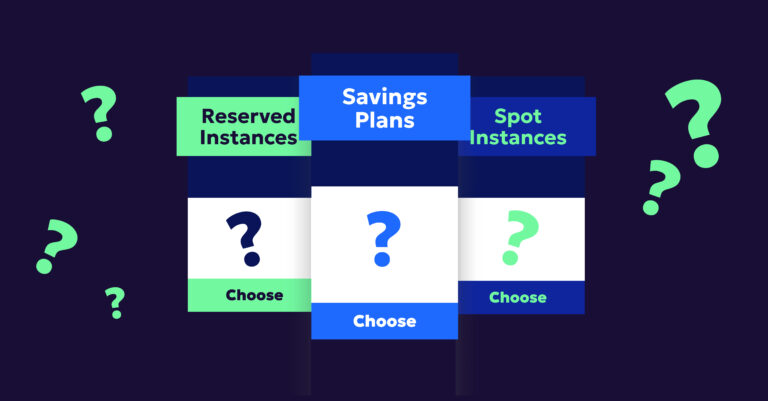
How to maximize your reserved capacity utilization
Cloud computing costs can aggregate quickly, especially if you’re relying solely on On-Demand instances. They offer maximum flexibility, allowing businesses to scale up or down without any upfront payment or long-term commitment. However, this flexibility comes with a premium, making On-Demand instances the most expensive option.
As a solution to these high costs, AWS offers discounted pricing models such as Reserved Instances, Savings Plans and Spot Instances. While RIs and Savings Plans demand commitment to a defined usage/specific instance type in exchange of great discounts, Spot Instances offer an opportunity for users to bid on unused Amazon EC2 capacity and leverage the most discounted cost.
However, these discounted models carry inherent risks, such as reduced flexibility and the potential for unutilized resources due to forecasting challenges. The primary challenge lies in inefficient commitment management. This usually leads to either reliance on On-Demand pricing to avoid the hassle or unused commitment plans, both of which result in wasted cloud resources. Thus, this article will guide you on optimizing discount plans effectively to manage costs while mitigating associated risks. Read on!
Understanding the Different AWS Discount Pricing Models
AWS offers a variety of pricing models to accommodate different usage and budgetary requirements, including On-Demand Instances, Spot Instances, Reserved Instances (RIs), and Savings Plans. Each model is designed to offer flexibility and cost savings under different conditions:
- On-Demand Instances allow for the most flexibility, letting users pay for compute capacity per hour or per second without any commitments. While this model offers maximum adaptability, it represents the highest cost option available.
- Spot Instances provide an opportunity for users to purchase unused AWS capacity at significant discounts, sometimes up to 90% off the On-Demand price. The trade-off is that these instances can be interrupted by AWS with just a two-minute notice when AWS needs the capacity back, making them ideal for flexible, interruptible workloads.
- Reserved Instances are available in two main types: Standard Reserved Instances (SRIs) and Convertible Reserved Instances (CRIs). SRIs can offer up to 72% off On-Demand pricing with a commitment to a specific instance type and AWS region for either 1 or 3 years. CRIs provide up to 54% savings and allow for changes in instance family, OS type, or tenancy during the commitment period, offering greater flexibility than SRIs but with slightly lower discounts.
- AWS Savings Plans can offer savings of up to 72% compared to On-Demand pricing, in exchange for committing to a specified amount of usage, measured in $/hour, over a 1 or 3-year period. AWS Savings Plans provide added flexibility compared to RIs, allowing the committed spend to be applied across different AWS services.
The Financial Challenge: On-Demand vs. Commitment Plans
The pay-as-you-go flexibility of On-Demand instances is appealing. That appeal drives many businesses to shy away from cost-saving opportunities, opting for On-Demand pricing due to a reluctance to commit to long-term plans. This reluctance is fueled by uncertainty in demand forecasting and the complexities involved in commitment management.
However, opting for On-Demand as a strategy to avoid long-term commitments comes at a high cost. In today’s dynamic business environment, marked by fluctuating markets, rising interest rates, and inflation, cost optimization isn’t just a goal—it’s a necessity. An appropriate blend of AWS Discount Plans, customized to your changing workloads, offers a way forward. The key to effectively leveraging AWS Discount Plans lies in striking a balance. By carefully planning and monitoring cloud usage, businesses can enjoy discounted pricing without falling into the trap of underutilization or financial risks. However, finding the perfect blend for your needs requires continuous tracking of usage, optimizing instance types, and adjusting to changing needs over time – which can be very time consuming if done manually.
The “Risks” of Not Using Discount Plans Optimally
Opting for AWS Discount Plans can lead to substantial cost savings. Yet, without strategic management, there are pitfalls to be wary of.
- Fear of Missed Savings:
When businesses commit to AWS Discount Plans, the aim is to match commitments closely with actual usage. However, inaccuracies in predicting needs can lead to overcommitting—paying for more capacity than required—or undercommitting and missing out on potential savings. For instance, a company may anticipate higher demand due to a new government policy and overcommit, only to find that the policy doesn’t get implemented and demand doesn’t increase as expected, leading to waste.
- Time to Savings:
The financial benefits from these discount plans are not always immediate and can take months or up to a year to become evident. This delay might deter businesses seeking quicker returns on their investments, particularly startups operating on tighter budgets. This is why it is imperative to choose the right solution for your environment, one that decreases the Time To Savings and understands how to achieve it faster.
- Lack of Flexibility:
Discount plans like Reserved Instances bind businesses to specific configurations or regions, potentially limiting operational flexibility. For example, a tech startup might commit to m5.large instances for their product, only to realize midway that c5.large instances are needed instead due to a pivot in development strategy. This misalignment between commitment and need can constrain innovation, resulting in financial inefficiency.
Managing Risks and Maximizing Value Using AWS Discount Plans
Effectively leveraging AWS Discount Plans requires a strategic approach to balance cost savings with operational flexibility. Here’s how businesses can manage risks and maximize value:
- Strategies for Mitigating the Fear of Missed Savings:
Diversifying your portfolio between short-term and long-term commitments across SPs, CRIs, and SRIs can create a balance that suits various workloads. SPs and SRIs are both ideal for predictable, stable workloads, while CRIs offer adaptability for dynamic or evolving projects. Continuous monitoring and management are crucial to adjust these commitments as your business needs change, ensuring that investments remain aligned with actual usage.
- Effective Savings vs. Utilization:
It’s important to focus on net savings rather than just discount plans’ utilization. For example, if your workload is volatile and at times you’re over-provisioned with a Discount Plan, the key question is whether the overall net savings outweigh the costs compared to On-Demand pricing. An overprovisioned Discount Plan might still offer positive net savings, underscoring the importance of evaluating the overall financial impact rather than just Discount plan’s utilization.
- Enhancing Flexibility with RIs:
Selecting the appropriate type of discount plan is crucial. CRIs, for example, provide more flexibility by allowing changes to instance types or regions, accommodating shifts in workload or strategy. Understanding your usage patterns and planning strategically can help mitigate risks associated with inflexibility.
- Expertise and Tools for Commitment Management:
Optimizing Discount Plans for maximum savings requires both expertise and significant time investment. Tools like Zesty’s Commitment Manager can streamline the process with Automated AWS Discount Management powered by Machine Learning algorithm. It eliminates vendor lock-in, removing the need for long-term commitments and enabling flexible discount allocation across workloads without manual effort.
With Zesty, businesses can effortlessly streamline cloud management and mitigate the financial risk of purchasing one or three-year commitments. It also ensures tangible savings, making Zesty’s Commitment Manager an essential asset for cloud cost management.
Explore more details about Zesty’s Commitment Manager or book a demo now!







